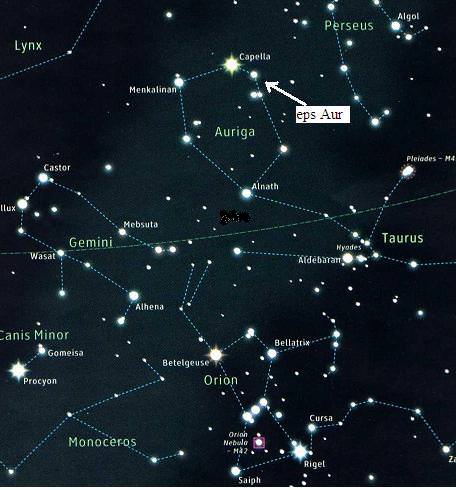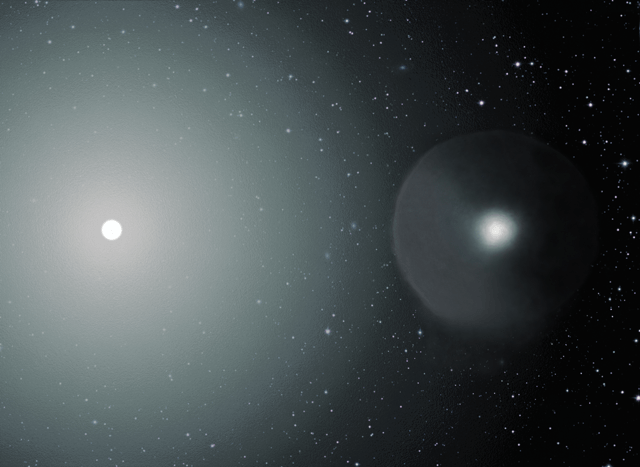If you’ve been helping out with the Citizen Sky project to monitor Epsilon Aurigae, then congratulations – the first of the results are in! Donald W. Hoard, a research scientist at Caltech announced the findings at the American Astronomical Society meeting in Washington, D.C. this morning. We invited our readers to participate in monitoring the star in August of 2009, and combined with observations from Spitzer, a 200-year old mystery has potentially been solved.
Epsilon Aurigae is a bright star in the constellation Auriga. It began to dim in brightness last August, which it does every 27 years. The star dims for over 2 years, with a slight brightening in the middle of the eclipse, making it the longest known orbital period for a stellar eclipse. The Citizen Sky project invited professional and amateur astronomers alike to aid in the observation of the star during this eclipse.
What exactly passes in front of the star was a mystery, though it was thought that a large disk of material with two stars orbiting tightly in the center is the cause of the eclipse. The disk itself is pretty huge – on the order of 8 astronomical units. There is a slight brightening during the middle of the eclipse that led astronomers to believe there is a hole created by the two stars in the center.
“If [Epsilon Aurigae] were an F star, with about 20 times the mass of the Sun…a single B star at the center of the disk doesn’t have enough mass to explain the orbital dynamics,” Hoard said. Other possibilities proposed were the presence of a black hole at the center of the disk, but there were no telltale X-rays coming from the system that would show a black hole was heating up matter in the disk.
Through observations by astronomers that participated in the project, as well as observations made by the Spitzer space telescope, a major revision of the properties of Epsilon Aurigae itself were in order.
“What we were most pleased to find an answer to… was that the results strongly tip towards a 2 solar-mass dying star. Sometime in the next few thousand years it will emerge as a planetary nebula,” Hoard said.
This means that instead of being a 20 solar-mass F-star supergiant, Epsilon Aurigae is in fact a 2 solar-mass F-star which is in the last stages of its life, and thus giant in size – about 300 Suns across. This, combined with a single B-star of about 5.9 solar masses at the center of the disk that orbits Epsilon Aurigae fit the observations very well, Hoard said.
Arne Henden of the American Association of Variable Star Observers (AAVSO), commenting on Hoard’s presentation at the press conference, said “Don says that we solved it, and I disagree. We need to determine the nature of the dusty disk that is involved – these are things that you see around young stellar objects, not older stellar objects.”
Hoard said that there was a curious property of the disk in that it was composed of larger grains of dust – more like grains of sand than microscopic dust motes.
“The observations that are being made by Citizen Sky project…will hopefully help answer this by providing answers about the composition of the disk and the temperature zones as the eclipse continues. We have these results in large part due to the effort of this huge group of citizen astronomers that are observing Epsilon Aurigae,” he said.
Epsilon Aurigae is still undergoing its eclipse, though the first phase ended right around the New Years Eve 2009. It will continue to be dim until early 2011, when it will begin to brighten again. There is still a lot to be answered about this system, and your help is needed, so keep (or start) observing and reporting! For more information on how to do so, visit Citizen Sky.
Source: AAS press conference on USTREAM, Citizen Sky press release


Cool, but I have a question…
Quote:
“This means that instead of being a 20 solar-mass F-star supergiant, Epsilon Aurigae is in fact a 2 solar-mass F-star which is in the last stages of its life. This, combined with a single B-star at the center of the disk that orbits Epsilon Aurigae fit the observations very well, Hoard said.”
If it is a B star, it should be very bright, and more massive by a long shot. Why would it be orbiting a lower mass star?
Or did I just completely misunderstand this statement….
@Dark Gnat –
Sorry about that – Hoard didn’t give the mass of the B-star during the press conference (unless I missed it, which is possible), but it was later given over at Citizen Sky, along with some other facts about the system. I’ve updated the story accordingly, and here’s the link to their review of his presentation: http://www.citizensky.org/content/aas-meeting-report-new-solutions-epsilon-aurigae
As for the brightness of the star being lower than you’d expect for that sequence star, my understanding is that the disk is masking much of the light coming from the star.
~Nick Wethington
From the citizensky link
“With the adopted distance (625pc), inclination (89 degrees) and orbital separation (18-20AU), the implied mass range for the F star is only 2-3 solar masses. That is far smaller in mass than a true supergiant star (as previously assumed) and resembles what is called a Post-AGB star – a state occurring after the Red Giant and Asymptotic Giant Branch portions of stellar evolution. The F star is super-giant in size however, nearly 300 Suns across! If confirmed, epsilon Aurigae’s primary star offers insight into this unusual stage in stellar evolution.”
Do I understand this right: the F-star is the lighter of the two because it has lost most of its mass during the previous AGB stage?